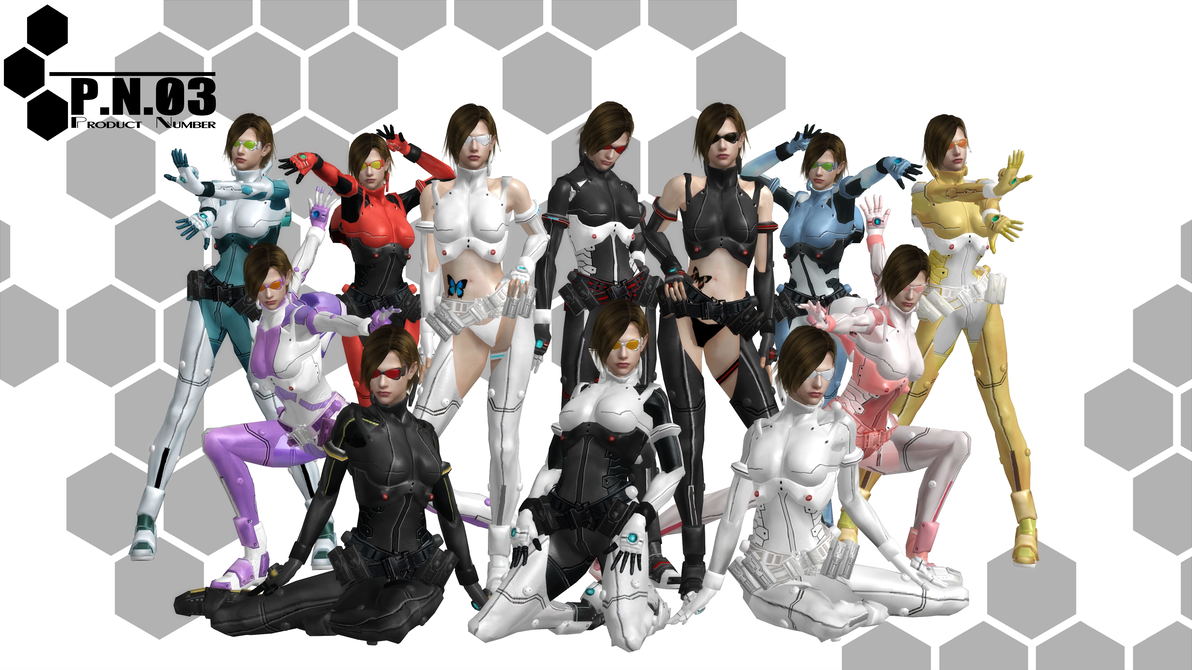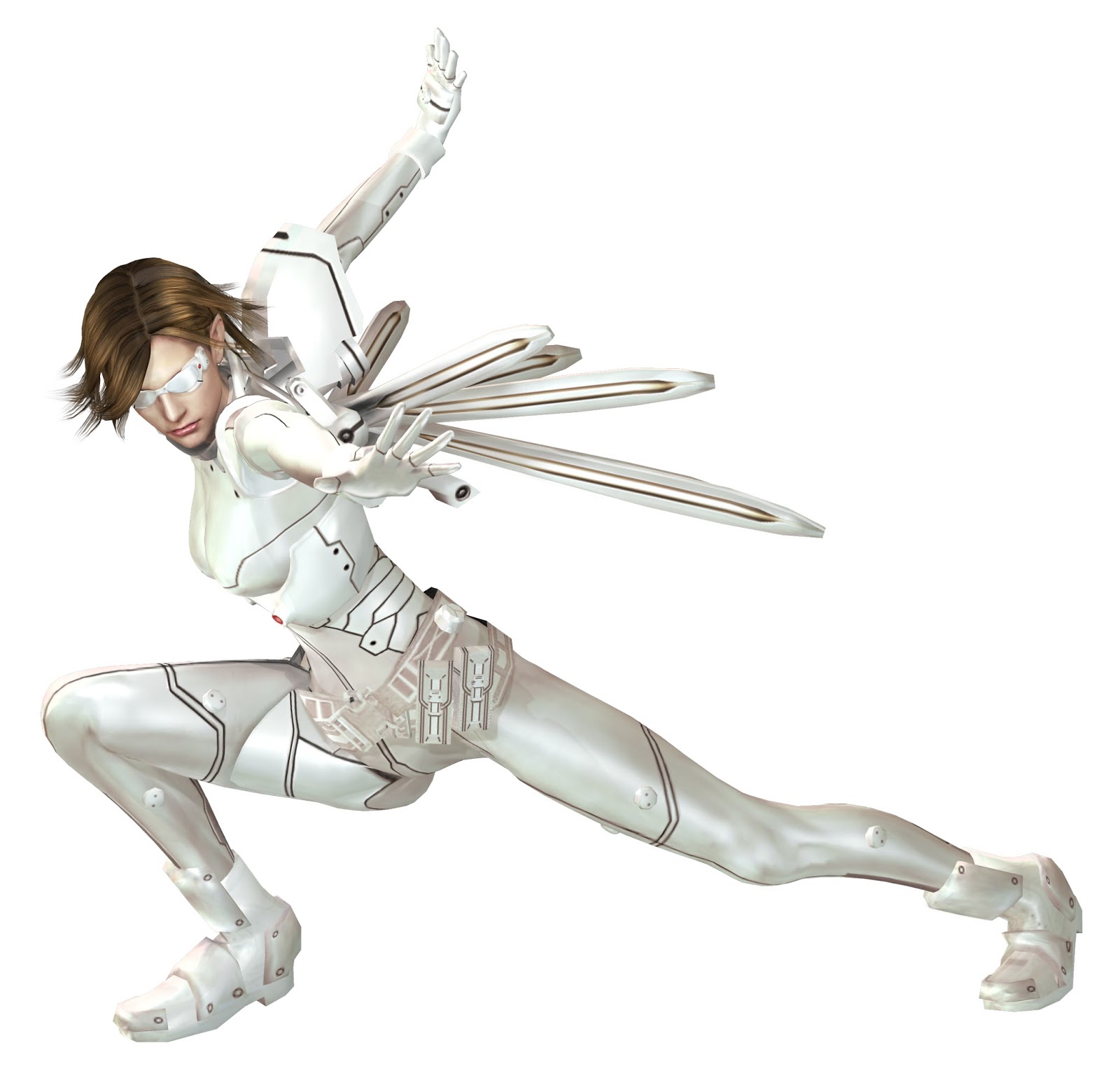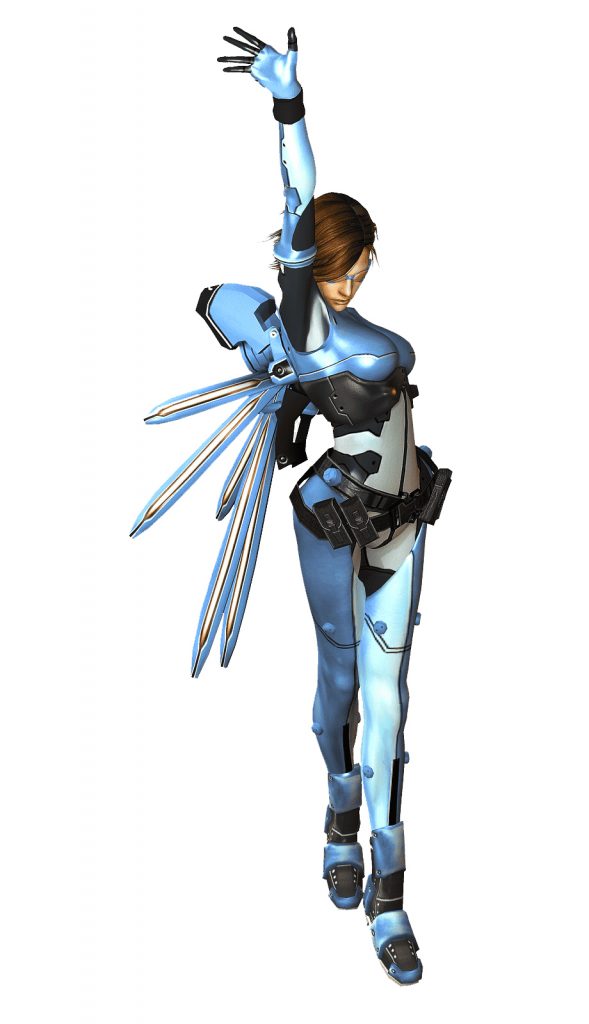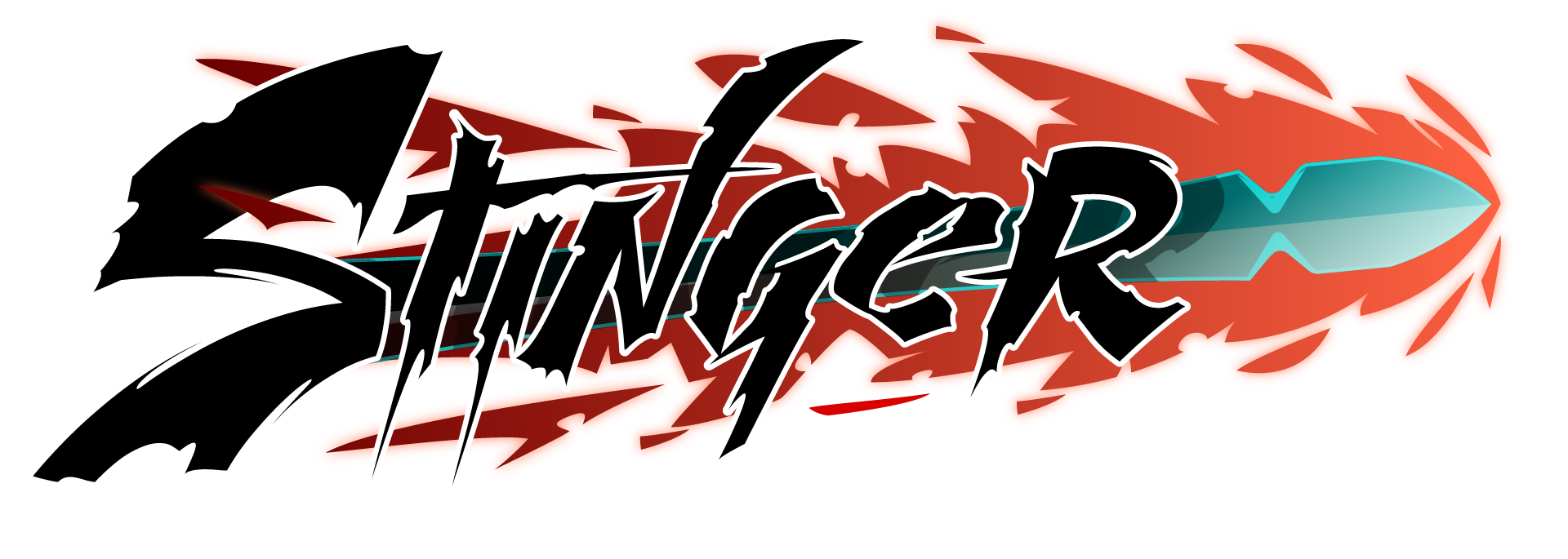You tap your feet on the floor at a tight rhythm. Shots fire and bounce off the walls. An engine roars and you lift your leg up to the beat and snap your fingers. Nothing can hold you back. Your head bounces, you nod as foes fall before your magnificence. As the screen fades you see how well you did while your head keeps nodding. The beat forces you to press on.
You are playing P.N.03
Congratulations, for you are one of the few. However, is this a blessing or a curse?
P.N.03 was part of the – now infamous – Capcom Five: a series of five games made by Capcom exclusively for the Nintendo Gamecube. The concept behind them was that Capcom felt the gaming industry was slowly stagnating, their own products included, and they wanted to give birth to new intellectual properties. These new games were set to launch yearly, starting in 2003. Originally, those games would be Viewtiful Joe (2003), Robot War Game (2004), Resident Evil 4 (2005), Killer 7 (2005 as well) and Dead Phoenix (2006). Viewtiful Joe would lead the pack, being directed by Hideki Kamiya. Meanwhile Shinji Mikami would focus on directing Robot War Game, Resident Evil 4 and Killer 7.
Yet, shortly after the public announcement of the Capcom Five in late 2002, an internal delay hit Viewtiful Joe which forced it out of the fiscal year. As a result, Robot War Game was pushed to the front of the release calendar. After only five days of development Mikami changed the direction of the game towards that of a more action-shooter with a clean design aesthetic, to set it apart from his other Capcom Five titles like Resident Evil, which had a more bleak visual tone.
Because of the now much tighter deadline, Mikami rushed to a character designer saying “draw the design of the hero, immediately“! When the designer started to ask questions about the design, like the gender of the protagonist, Mikami recollects that he quickly responded with “What do you like to draw, man or woman?“. The designer chose a woman, to which Mikami ended the conversation with “then it is so“. And thus protagonist Vanessa Z. Schneider was born.
As the production was picking up pace and the first gameplay prototypes were coming together, Mikami intended for the game to be called Jaguar, in reference to Vanessa’s agile motions. Staff members didn’t care for that title however, forcing Mikami to come up with a new name. The final name would be Product Number 03, shortened to P.N.03, to give off a more mysterious feel.
Despite the short deadline of only seven months to work on the title, the game saw its release on time in March 2003. While previews garnered positive reactions, like IGN calling P.N.03 “the most promising of the bunch” in regards to the Capcom Five, reactions on launch were negative, including those of its own director when he reminisced about the title in 2010.
“The real reason is, Viewtiful Joe slipped out of the fiscal year, so I had to do something to fill that gap. I think it should be OK to talk about that now. And really, that isn’t a very good reason to make a game.”

Shinji Mikami
director
Was some of that early anticipated ‘promise’ that the game held still there though? Looking at the combat, one can best describe P.N.03’s action as a dance. Tapping the Gamecube’s A-button stretches Vanessa’s arms out, shooting bolts from her palms while she snaps her fingers to the rhythm. A well timed press of a shoulder button sends her cartwheel to safety while a single press of the B-button lets her do a little jumping pirouette.
Should the fight get to you, one can activate special Energy Drive moves that are performed through d-pad commands; highly choreographed moves that deal good damage at the expense of her suit’s energy. All her animations are shaped like dance moves and rhythmic twists, giving them a strong feeling of style.
Once you start dancing, enemies start to fall apart. Killing foes in a row will start a combo-chain with larger combos giving more points if you manage to kill enemies within the allotted time. These can then be spent on one of 10 new suits that emphasise attack or defense, or give access to different Energy Drives.

These Drives come in various shapes and sizes. Swan (right+left+A) fires four homing lasers which is great for fighting groups, Gullwing (left+right+A) shoots out a big grenade-esque ball while Griffin (up+down+A) has Vanessa create a shockwave that hits through cover. Others are less about damage, such as Tengu which renders Vanesse invulnerable while doubling the damage of her regular shots.
What Drives you want to use depends on the rooms and your strategy for them. One room might be nearly impossible to clear in a single combo without the use of Pegasus’ room clearing ability or smart usage of Tengu allowing you to avoid enemy attacks while keeping up the pressure, rewarding experimentation and replayability. Sadly, due to most suits only having access to one to three drives, it is easy to play favourites. And with each room giving bonus points if cleared without taking damage,Tengu’s offer of invincibility often takes the crown. To add insult to injury, the Gamecube’s unreliable D-pad can lead to Drives not registering in times of crisis, making the more complicated inputs of down+left+up+A of Harrier Pro less inviting.
And often it will be a crisis. P.N.03’s over-all combat sees players traversing through a single room. When finished the player is then ranked on their maximum combo, clear time and possible no-damage bonus. Each room has a few possible variations of what enemies are in them. Compared to Vanessa, enemies are slow, robotic and wooden in their movement, while some are completely stationary.
Their key-aspect are their strong visual and audio cues for each of their attacks. Some are a barrage of bullets to the right, another a dash forward that is always followed by a sweeping laser or a big shock wave that needs to be jumped over. Like most titles P.N.03 starts it slow, with each foe only appearing individually, while later missions try to mix and match enemies together to create harder encounters.
These fights are often in rooms with a clean white aesthetic. Producer Hiroyuki Kobayashi recalls that, once the gender of Vanessa was decided, they wanted to portray the world as such too. A feminine world of thin lines, strong whites and a delicate image leading to a minimalistic approach to level design. That aside, they also help the enemies and Vanessa stand out, making it easier to see. A thought process he would later re-use.
Many of the rooms are repeated throughout the game however, once again thanks to the game’s tight deadline. Some rooms will be visited more than a dozen times, with only a few variations in enemy layouts and sometimes the area will be mirrored. One could compare each enemy to a small puzzle-piece that needs to be solved, while the room itself is the big puzzle to crack. Although this could be interesting, especially for players doing speed-and or highscore runs, due to their similar design and singular focus of the game’s combat the game can become a blur if played for long sessions at a time. Moreso if the player dives into the randomized Trial Maps.
In a way, P.N.03‘s structure of short room encounters with slow moving enemies can feel like a throwback to old-school shoot ’m up games.

This is what they were going for, as Producer Hiroyuki Kobayashi noted: “the gameplay is essentially reminiscent of a tough, old school arcade shooter“. And just like those arcade games of old, shooting in P.N.03 is done by tapping a button, not holding it down. One press equals one shot. While this could be seen as annoying, it does force new players to make each shot count, if only to save their thumbs. It isn’t until later in the game that the player can unlock suits that allow you to hold down the fire button.
Ask any player who just finished Mission 3 how many shots it will take to kill a >AAW-09 Eichel or >ASS-13G Seerose and he will be able to tell you. After Mission 7 they will draw an entire map of each room variation. In their second playthrough they will school you on their cleanest and quickest way to beat a room without getting hit and which suits and Drives are best used for that level. At the end of their third playthrough one can put a Gamecube controller in their hands, play a few of the game’s audio cues used to warn the player of incoming attacks and see their fingers move on the controller in response; the puzzle has been cracked. This form of memorization plays a crucial part in the game’s core design, akin to the dance-like rhythm of Vanessa’s moves.
One could ascertain that the game might’ve held up better had it stuck to a more traditional arcade experience, or rogue-like setup, with randomized rooms but with set enemy placements. As it stands, the game’s linear structure at times works against its reward for replayability.
While building this memorization one might call P.N.03 “clunky” or “wooden” in terms of movement and it’s easy to see why. Moves don’t overlap for instance. If you’re shooting, you cannot dodge. You cannot attack while moving, cannot immediately jump after dodging and getting hit slows the game down to a crawl. Each input is important. After multiple runs throughs though, with the knowledge gained, you’ll be stringing combos together, rolling underneath laser fire and dodging left and right with perfect timing. You’ll know exactly when to use your Energy Drives, where the energy-pickups are and which rooms can be skipped for a highest score.
Again, P.N.03 is like dancing; at first it’s awkward and clunky, but once you know what you’re doing it is magic. It just takes time to get that far.

Most of this magic, the good and the bad, originates from the mentioned tight deadline. Original images and footage show Vanessa wielding a gun and other weapons, which were scrapped to save time on animation. Instead she would now fire only a single weapon with her hands which allowed for some quick creativity i.e. seeing the animators throw small dance-style like motions into the mix, giving the game its style.
Lastly, the short development time especially rears its head when it comes down to the length of the game which, if one doesn’t touch the randomized Trial Missions, clocks in at around two hours. The story is also barely present, containing only a single introductory exposition of 30 seconds explaining why Vanessa is in a cloning facility over-run by berserked CAMS robots, while the final cutscene lasts exactly 1 minute barely tying up any ends. It is clear that Mikami and his team decided to focus on the gameplay.

And faced with such a tight deadline, it’s good that Mikami did so. Being a game so focused on rhythm and memorization, it is the purest modern example of an 覚えゲーgame as one might find; pronounced OH boe GHe meaning “remember the game”. Once mastered, Vanessa is like a swan among bourgeois pigs in a temple painted white with echoes of blaster fire. And if you think you’ve mastered the game and all its patterns P.N.03 will offer one final challenge. To don the extra revealing Papillon Suit which gives access to all the game’s Energy Drives, but reduces your health to a single digit. Beat the whole game using this suit and a hidden steamy cutscene shall be your reward.
Despite this allure, P.N.03 was a financial failure. It’s shortcomings and rushed nature resulted in bad reviews that emphasized its short run time and controls. Understandable, as the game’s drive for mastery isn’t enough for everyone. Paired with a normal price tag it never saw much love, seeing it end up as the only game of the Capcom Five to never be ported to another system.
P.N.03 in essence is the only real game of the Capcom Five that stuck to its goal: to be a unique exclusive game by Capcom for Nintendo’s Gamecube. Yet unlike many other failed games, P.N.03 does not entertain a cult following. There is no grand fan forum, no secret tournaments for high-scores and only a single Youtuber covering it. Instead it entertains a few lone fans around the globe, connected only through their unbeknownst shared passion for this little title that could have been so great; if only its creators had gotten more time. Though perhaps, what beauty P.N.03 does possess was born exactly because of its rushed nature.
It might not be the best game the first time through, but it is one that gets better and more fun with each runthrough as you’ll always improve and find new tactics or suits to experiment with. And in a world where games are slowly shying away from replay value in favour of a singular experience, it’s good to still have some of those great replayable gems out there.
Mastery never felt this great.
鑒 reflection style 鑒
In this short section I reflect on the article from my own viewpoints as a gamer and lover of the genre instead of a critic.
For me P.N.03 is Darude – Sandstorm. A quick Youtube-search will result in finding a music video which combines all sorts of footage from P.N.03 mixed with that famous song. The beats are a perfect fit for a game like this.
I bought P.N.03 shortly after having finished my seventh playthrough of Alpha Protocol, a gem of a game which was blasted with horrible reviews with some even calling it one of the worst games ever made. The number of playthroughs mentioned should already give it away, I quite liked that game. After being confronted (yet again) with the fact that commonly accepted bad games could be good, I decided to hunt P.N.03 down.
I had been pulled in by its visual cover years ago. Back in secondary school I recall a friend having bought the game and hating it for being repetitive and lacking multiplayer, so I never touched it despite the box-art’s allure. When I finally did purchase the title I was not disappointed; quickly finishing the game six times in a row before the feeling of repetition set in.
I never managed to beat the Papillon challenge as my current save-file was set to Hard and I didn’t have enough points to unlock Tengu Pro; which would have made the run a lot easier. It is still one challenge I wish to finish, not for the secret cut-scene that is unlocked (which sadly in this day and age can be easily googled, and isn’t as steamy as one would hope to believe), but for the accomplishment. Though far from a finished game its combat is one based on such fundamentals of memorization that it will be a timeless cult-classic and one I still pick up from time to time. I do wish it would get a re-release however, though the chances of this are slim.
斬 postscript notes 斬
- The title of P.N.03 has many rumors surrounding its origins, some stating that it literally meant its production number within the Capcom Five which was subsequently used as working title due to the harsh deadline; this is false. The one mentioned in the article is most commonly regarded as true;
- Because P.N.03 takes place in a space colony, Mikami wanted Vanessa’s country of origin to be ambiguous. Her name hails from numerous countries. Of the name “Vanessa Z Schneider”, Vanessa comes from France. Meanwhile the middle name is from England and the last name, Schneider, is German;
- This article was re-written and updated to fit the new website nearly two years later (2019). It was shocking to me just how messy this article was at times and how much information was missing or omitted. I learned a lot over the last two years, that’s for bloody sure!
- This was the third title of the Capcom Five that I played, the first being Resident Evil 4 followed by Viewtiful Joe. Coincidence? I think not;
- Vanessa, while not very talkative, is voiced by Jennifer Hale. While now famous for her role as Female Shepard in the Mass Effect Trilogy she was then of soon to be fame as Sheena in Tales of Symphonia and the overpriced originator of all screams and grunts of Metroid Prime‘s Samus Aran;
- Mikami has often stated that he’s not proud of P.N.03. As such he reused a lot of ideas and built on them further with his masterpiece Vanquish in 2010;
- Despite its cult following, there’s a surprising amount of risque artwork of Vanessa;
- Though the name Jaguar was dropped, one animator changed Vanessa’s crouch animation to one that resembles that of a jaguar as a nice little call back;
- As noted by Mikami at the time, a CGI model can only get so beautiful, and there’s more to a design than physical beauty. It is the way the character moves that sells you on her. This is why the contrast between her fluid motions and the enemy’s more robotic features were so important;
- This article was originally written April 8th 2017 and was updated June 12th 2020. I felt that while the key parts of the article were still on the mark, it was jumping too much between points and never really analyzed what worked and what didn’t in the game’s combat system. Hence the rewrite. Unless something new comes to light, this article won’t receive any more updates.
源 sources 源
- https://n4g.com/news/582642/edge-interview-shinji-mikami
- https://www.ign.com/articles/2002/11/13/capcoms-fantastic-five
- https://web.archive.org/web/20121104183751/http://www.computerandvideogames.com/89343/interviews/interview-pn03-unloads/
- https://web.archive.org/web/20130405172458/http://www.capcom.co.jp/pn03/pn03_cl/pn_cl02.html
- https://web.archive.org/web/20130405172222/http://www.capcom.co.jp/pn03/pn03_cl/pn_cl01.html
- https://web.archive.org/web/20130405200607/http://www.capcom.co.jp/pn03/pn03_cl/pn_cl03.html
- https://web.archive.org/web/20110829111910/http://www.next-gen.biz/features/interview-shinji-mikami
- https://www.ign.com/articles/2003/09/08/pn03-interview-hiroyuki-kobayashi
- https://web.archive.org/web/20101023155948/http://www.next-gen.biz/features/time-extend-pn03
- https://kotaku.com/remembering-capcoms-great-nintendo-promise-betrayal-5806800
- https://web.archive.org/web/20080905044950/http://www.gameinformer.com/Games/Review/200309/R03.0821.1026.17899.htm


I’m actually trying to find who design the mecha and suits in this game, do you have any clue? Thanks
Hello Shawn!
Mechanical Designer Sho Sakai designed the robots. IIRC animator Kenichi Ueda designed and animated Vanessa, though this could’ve also been Sakai. Hiroyuki Kobayashi was the game’s producer and functioned as a sort of stand-in Art Director as well.
Hope this helped 🙂
Thank you! I saw some gameplay on Youtube and the mecha design is kinda reminds me for MGS, so I wondering if there is any connection 🙂
You’re welcome! Alas they are different designers, but Yoji Shinkawa is a very influential designer in Japan, really one of the top dogs, so it could very well be that Sho Sakai was inspired by him at the very least 🙂
😥Once a year, I search Google for any news on a re-release or remake.
It had its faults but I did love this Game.
The Original Soundtrack was AMAZE-BALLS and I have it on my ‘phone.
I’m currently using a Switch and would love a release on it.